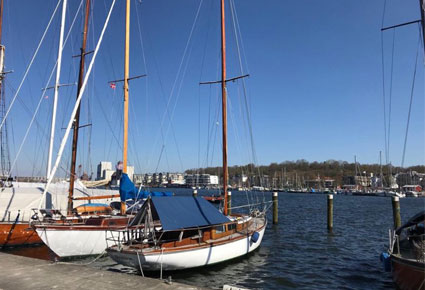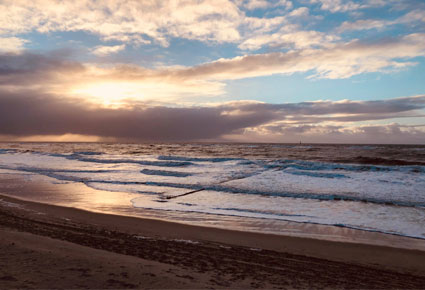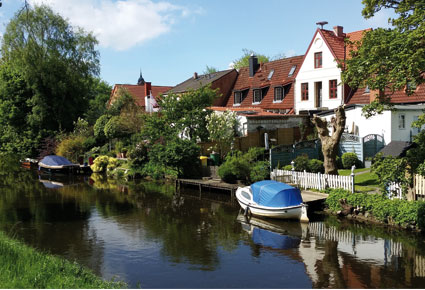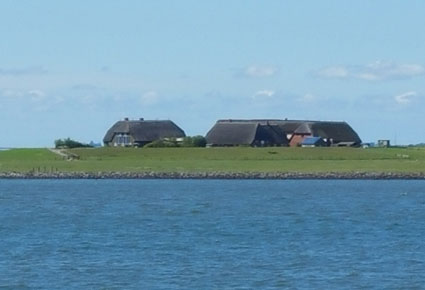Trips
Husum
Hususm (Frisian: Hüsem) is the county seat of Northen Frisia in Schleswig-Holstein. Since the flood of 1362 the town is situated next to the sea and soon got a harbour. Aesthetically Husum is known for its poet Theodor Storm: “… but my whole heart is devoted to you, grey town near the sea.” Visiting Husum makes one realise why Theodor Storm lost his heart to it – but it is not grey, but colourful and bursting with life instead. Its castle, which by the way is the only one at the Schleswig-holsteinian coast of the North Sea, it’s ancient town centre with its small alleys and tall gabled houses, its picturesque harbour as well as different museums and other sights are waiting for you to discover them. Plenty of movies and the series “Herzschlag –Ärzteteam Nord” made Husum well known even across Germany’s borders. An especially beautiful sight to visit is the blossom of crocus at the park of the castle in spring. You’ll be enchanted by the violet carpet of flowers.
Flensburg
Flensburg is the third biggest town in Schleswig-Holstein and the most northern independent city in Germany. It was founded as early as the 12. Century. For many centuries Flensburg was the center of conflict between Holstein and Denmark. Today it is widely known for its rum, beer and the infamous “points” collected at the “Kraftfahrt-Bundesamt”, where the records of German traffic-related offences are kept. But there is far more to Flensburg! Feel free to discover the ancient harbour and its shipyard-turned-museum, Flensburgs gem, the “Rote Straße”, and of course the town’s landmark, the Nordertor. Enjoy the northern flair of cafés, restaurants and other spaces to linger. Or you could visit the german-danish tourist area around the Flensburger Förde, the bay of Flensburg, with its many beaches and gentle hills – paradise for adventurous days! Explore primal forests and small villages alongside picturesque coasts on bicycle or on foot or try out the offers of water sports at the “Wassersportparadies Flensburg Fjord”. Fascinating castles and exciting museums offer cultural diversions for everyone.
Sylt
Sylt is the fourth-biggest island of Germany and the biggest German one in the North Sea. A beach of about 40 kilometre stretches along its western side while at the eastern side you will encounter the mud flats, which are part of the national park Schleswig-Holstein Wadden Sea and mostly fall dry at low tide. Sylts’ fauna is ruled by the original barenness of the land. Its east is covered by vast heather-areas like the “Braderuper Heide”. Creature, who are fit to survive in these extreme conditions (drought, warmth and wind) live here, most of them at other places been nearly extinct.
Tourism in Sylt startet as early as the 19. Century. Back then many artists came to visit the island. Since the beginning of the 20. Century Sylt is being visited by more and more tourists. Nevertheless the island has kept its original beauty, but recent years have brought a loss of land due to forces of nature. Apart from nature there are a lot of different activities to do, such as visiting the Sylt Aquarium or the museum of forces of nature.
Niebüll
Until 1970 Niebüll was the central town of the county Südtondern. With the railroad line between Hamburg and the coast of the North Sea completed, Niebülls importance grew. The painter Emil Nolde made Niebüll famous by living close to it. Sights here are the City Centre, an open-air museum, a museum of nature and the nearby Nolde-Museum, where nature and culture meet. Nowaday Niebüll is known as the way to the coast of the North Sea and, of course, to the islands.
Tondern
Tondern is situated in Denmark, close to the German Border and used to be the centre of the county Tondern, to which Niebüll belonged as well. Tondern is one of the oldest towns in Denmark and in medieval times used to include a harbour. Throughout history it lived through floods, fires, the plague and wars. In World War One zeppelins used to be stationed here by the military. This is commemorated in the “Zeppelin- und Garnisonsmuseum”. Its varying history makes Tondern worth a visit. Walk through town and you’ll discover quiet streets with houses of patricians build in 17. and 18. Century or museums such as the museum of art and the museum of tatting. History is still alive here in the body of the pillory at the market or the imposing church Christkirche. Every year in August the town is home to the biggest folk-music festival in Europe.
Ribe
Visit the oldest town in Denmark! It was founded by an eager missionary, who built a church here in 860. At the time this was the most important merchants place at the coast of the North Sea. Many archaeological finds bear witness to ancient culture and trade relations to Northern Germany, the Netherlands and England. Ribe too has had its share of floods, fires and the plague in medieval times. Nonetheless its ancient city centre still is in good shape. There are old half-timber houses, a gothic town hall, a monastery and of course the famous cathedral, which is the oldest in Denmark, built in the 12. Century. You can climb up the tower and enjoy the view across the city centre. Or why not take a look at the rebuild Viking village?
Föhr, island in the North Sea
Föhr is a green paradise for your holidays. Here you can hike, cycle, surf, sail or relax at the beach. Wyk, the only town on the island, has been a beach resort since 1819, which makes it the oldest in Schleswig-Holstein. From 1842 to 1847 Wyk held the summer residence of the Danish royal family. There are 16 villages on Föhr, all of them governed by thatched-roof house and the Frisian way of life. Waiting for your visit as well are three old churches build of brick from the 12. and 13. Century, whispering tombstones, different sorts of exhibitions in the museum of art of the western coast and a lot more. Street cafés at the Sandwall, neat restaurants and quaint pubs are just a few of the options for enjoying yourself food-wise. From Dagebüll you can reach Wyk on Föhr in roughly 45 Minute by ferry.
Amrum, island in the North Sea
Amrum with its length of 12 km and area of 20 km2 is smaller than Sylt and Föhr but with its broad “Kniepsand” from what has formerly been an upstream sandbar and its big dune belt offers a variety of nature. Sights are the highest lighthouse of the German coast of the North Sea, the romantic villages of Norddorf, Nebel, Süddorf and Seenodde and the oldest church in Northern Frisia. Elaborately designed tombstones from times of whale fishing make the graveyard of Nebel definitely worth a visit. The trip from Dagebüll to Amrum on ferry takes about two hours.
Friedrichstadt
The small town Friedrichstadt is sometimes called “Amsterdam of the North”. Founded in 1621 by Duke Friedrich III and built by the Dutch it is known for its Grachten and Dutch gabled houses. Not only was it given municipal laws but Duke Friedrich III also established freedom of religion here, so that many religions found a home here. The only church of the remonstrants out of the Netherlands can be found here. This led to the name “town of tolerance”. Walking around town of doing a Grachtenfahrt you will encounter many interesting stories.
Helgoland
How about visiting Germanys only deep-sea island? Seeing the “long Anna” and the bird-rock on the main island or the grey seals on the neighbouring dune, if you like nature you’ll love the Helgoland. Walking along the island it’s easy to understand its changing history. Enjoy the fresh air, shop around the many stores at the Unterland or relax at the beach of the dune. Last but not least, Helgoland is the only island where you can shop duty-free.
From the dayke of Dagebüll you can already see the Hallig Oland. Alongside coastal proztection measures Oland has been connected to the mainland via a dam of roughly 5 km. The only terp of the hallig is home to a typical village of a school, a church and houses inhabited by around 30 people, all organised around the ancient feting. To Oland you can take a guided walk from Dagebüll when the tide is low.
Halligen
Theodor Storm once called them “swimming dreams”. You can’t find “Halligen” anywhere elase in the world. Visit the special man-made islands which are situated inside the UNESCO world heritage Wadden Sea.
Hallig Oland
From the dayke of Dagebüll you can already see the Hallig Oland. Alongside coastal proztection measures Oland has been connected to the mainland via a dam of roughly 5 km. The only terp of the hallig is home to a typical village of a school, a church and houses inhabited by around 30 people, all organised around the ancient feting. To Oland you can take a guided walk from Dagebüll when the tide is low.
Hallig Gröde
Hallig Gröde is famous for being the smallest political borough in Germany. Its inhabitants live on two terps. In its small but extraordinary church valuable things like the altar from 1592 can be found.
Hallig Langeneß
The biggest of the ten Halligen is Langeneß. As its name is already telling, it stretches a long way, roughly 10 km. Its 18 inhabited terps are populated by around 110 inhabitants. Its church holds lovely historic art. Other sights can be found in the “Friesenpesel” and the “Captain Tadsen-Museum”. The legendary “Halligexpress” crosses the Hallig starting from landing pier Rixwarft. Also you are able to rent bicycles.
Hallig Hooge
The second biggest Hallig became famous for its “Königspesel” where the Danish king Frederik VI stayed in 1825. The “Heimatmuseum”, the “Schutzstation Wattenmeer”, the flood-cinema and the church are interesting as well. Directly at the Anleger carriages together with guides are offered as well as bicycles for rent.









Hotel Neuwarft
Nordseestraße 20
25899 Dagebüll
Tel: 04667 95140
E-Mail: anfrage@hotel-neuwarft.de
Follow us:
